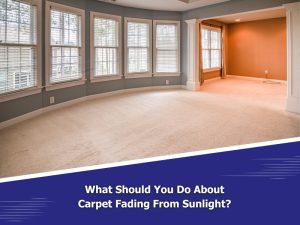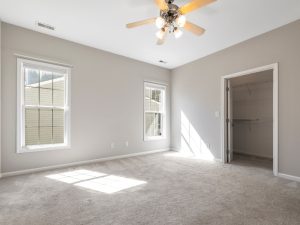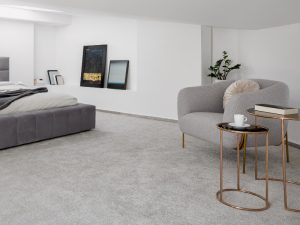What Should You Do About Carpet Fading From Sunlight?

Carpets are famous for creating warmth and comfort in residential and commercial spaces. However, one common challenge many face is carpet fading caused by prolonged exposure to sunlight. You’re not alone if you’ve noticed your carpet losing its vibrancy. This blog will walk you through the causes of carpet fading, how to prevent it, and what you can do to restore your carpet’s appearance.
What causes a carpet to fade from sunlight?
Carpet fading happens when the sun’s ultraviolet (UV) rays break down the chemical bonds in the carpet fibres, leading to a noticeable loss of colour. The degree of fading depends on several factors, including the type of carpet, the amount of direct sunlight it’s exposed to, and the intensity of UV rays.
Here are the key factors contributing to carpet fading:
- UV exposure: The primary cause of fading is UV light, which breaks down the dye molecules in carpet fibres over time.
- Type of carpet material: Some materials, like wool, are more resistant to fading, while synthetic fibres like nylon and polyester are more susceptible to sun damage.
- Duration of sun exposure: Carpets in rooms with large windows or that receive direct sunlight for extended periods will fade faster than those in shaded areas.
- Room orientation: North-facing rooms in Australia get more consistent sunlight, leading to increased fading compared to south-facing rooms.
How can you prevent carpet fading from sunlight?
While you can’t completely stop carpets from fading, there are several steps you can take to minimise the damage caused by sunlight. Prevention is always better than cure, and a few simple measures can extend the life of your carpets. Here’s how you can protect your carpets from sun damage:

- Install window treatments: Use curtains, blinds, or shades to limit the amount of sunlight entering the room, especially during peak UV hours (midday).
- Use UV-blocking window films. These transparent films can block up to 99% of UV rays, reducing their impact on carpets without obstructing your view.
- Apply protective coatings: To add an extra layer of defence, consider using UV-protective treatments on your windows or carpets.
- Strategic furniture placement: Move furniture around to cover carpet areas exposed to sunlight. This can help reduce direct UV contact.
- Opt for outdoor rugs near windows: If your carpet is in a high-sunlight area, an outdoor rug or runner can provide additional protection.
Can certain carpet materials resist fading?
Choosing the suitable carpet material can significantly affect how well it stands up to sunlight. Some carpets are more resistant to UV rays than others, and selecting a fade-resistant option is brilliant, especially for rooms with large windows.
Here are some materials that offer better fade resistance:
- Wool: Naturally fade-resistant, wool is an excellent choice for areas with high sunlight exposure. It’s durable, eco-friendly, and holds its colour well over time.
- Solution-dyed nylon: Solution-dyed nylon carpets have colour embedded throughout the fibre, making them more resistant to fading than surface-dyed carpets.
- Acrylic: Acrylic fibres mimic wool’s fade-resistant properties and are a more affordable option for areas exposed to sunlight.
- Polypropylene (Olefin): This synthetic material is highly resistant to fading and moisture. It is a good choice for sunny areas, though it may not be as durable as wool or nylon.
Should you use rugs or mats to protect high-exposure areas?
One practical way to protect your carpet from excessive sun exposure is by placing rugs or mats in areas with the most sunlight. This shields the carpet from direct UV rays and helps preserve its colour and texture in high-traffic areas.
Here are a few benefits of using rugs or mats:
- An extra layer of protection: Rugs can absorb the brunt of UV damage, keeping the carpet beneath intact.
- Easy to replace: Unlike fitted carpets, rugs and mats can be easily replaced or moved to different areas of your home or office.
- Enhanced aesthetics: A stylish rug can complement your décor while serving a functional purpose.
- Durability in high-traffic areas: Placing rugs in busy areas can help prevent wear and tear from foot traffic, extending your carpet’s lifespan.
How often should you rotate your carpets to minimise sun damage?
Rotating your carpets periodically can help reduce uneven fading caused by sunlight. This is especially important for large rooms where only one side of the rug is exposed to direct light. By rotating your carpets every few months, you can ensure that all areas receive equal exposure, preventing one side from looking significantly more faded. Here’s a quick guide for rotation:
- Every three to six months: Rotate carpets in sun-exposed rooms to distribute UV exposure evenly.
- Incorporate it into seasonal cleaning: Take advantage of seasonal cleanings to rotate rugs or carpets, keeping the carpet and space fresh.
- Check for signs of fading: Inspect your carpets regularly for early signs of fading and rotate them accordingly to prevent permanent damage.

Can professional carpet treatments help prevent fading?
Investing in professional carpet treatments can be an effective way to prevent fading. Some treatments are designed to offer UV protection and can be applied by flooring experts to give your carpet an added layer of defence against sunlight.
Here’s how professional treatments can help:
- UV-resistant coatings: Professionals can apply special UV coatings to carpets that help reduce the impact of sunlight and slow down the fading process.
- Stain and fade-resistant treatments: These treatments protect carpets from UV rays and prevent staining, keeping them looking newer for longer.
- Consulting experts: Professionals with advanced training in carpet colour restoration can provide tailored advice on the best treatment, ensuring long-lasting results.
What are your options if your carpet has already faded?
Don’t despair! If your carpet has already suffered some sun damage, there are a few things you can try:
- Professional cleaning: A professional carpet cleaning can remove dirt and grime that can exacerbate fading. Sometimes, a good clean can revitalise slightly faded colours.
- Professional dyeing: For more significant fading, professional carpet dyeing can be an option. However, this can be a costly process.
- Area rugs and furniture placement: Strategically placed areas can cover faded areas and create a more visually balanced look.
- Replacing the carpet: If the fading is extensive, consider investing in a durable carpet for sunny rooms. This will help restore the appearance of your space and provide long-lasting results.
Ready to restore your carpet?
If your carpet is beyond saving or you crave a fresh look, Cosy Group is here to help! We offer high-quality carpets in various styles, colours, and materials. Our friendly and experienced team can guide you in selecting the perfect carpet for your needs and sun exposure levels.
Choose Cosy Group for fade resistant carpets and breathe new life into your space with a beautiful, sun-resistant carpet!
